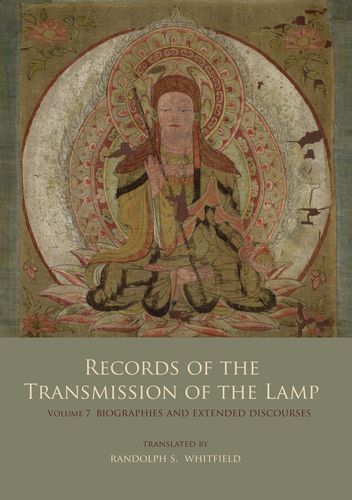
Martin Goodson
Records of the Transmission of the Lamp vol. 7
In this extract the translator discusses the thorny problem of history, truth and fiction and asks what 'truth' can mean when history is made up of the accumulated fictions of those who record it.

The Records of the Transmission of the Lamp stands as a distinguished literary culmination of centuries of moulding the plasticity of the Chinese Chan Buddhist past. Two streams run through the whole of Chan / Zen – the ever evolving historical stream and the ever authentic spiritual practice which adapts to the contemporary milieu in order to further its salvific activity into the future.
It all started, as far as literary Chan is concerned, with Bodhidharma coming to China. But all efforts to find an historical Bodhidharma have only come up against a wall. There are hints of his existence, but the legend takes on a greater reality. When we read, for example, in one of the most hallowed texts of Chinese Buddhism, the Further Biographies of Eminent Monks (Xu Gaoseng Zhuan T. 2061), composed in the 660’s CE by Daoxuan (596–667 CE), the most venerable of Chinese Buddhist chroniclers, that Bodhidharma’s heir, Second Chan Patriarch Huike, had his arm chopped off by bandits and that his fellow disciple, Tanlin, also had his arm chopped off by bandits; [6] when we read, about 350 years later, in the CDL, dated c. 1004 CE, that the same Huike chopped his [other] arm off to show Bodhidharma his sincerity for the Dharma, then clearly something had grown in the meantime.
Again, whether the monk Damo, mentioned in Mahāsattva Fu’s entry (27.2) is the same Bodhidharma, and what his possible relationship with the Mahāsattva, who taught the truth of ‘cessation but not annihilation’ actually was, will probably never be clear. [7]
… If Chan history teaches us anything it is that an account ‘based on the facts’ is just not possible. Past actions only seem to be unchangeable, yet there is a way of getting around the impasse – simply change the past! This makes all the difference, for were this way of changing the unchangeable not natural to us, then everything, our whole world, would have slipped into a deadly oblivion long ago. Anyway, who could bear to remember themselves as they really were?
The capacity to mould-warp an essentially plastic reality into a desired agenda by fictionalising one’s own history is something we have a need and relish for – in fact, we have always fictionalised everything. The activity of mis-remembering, mis-recording or just downright twisting ‘the facts’ constitutes our whole history from the very beginning of ‘records’.
If it were possible, as some think it might be in the future – another fiction- twister – to tap into the universal memory by some digital, rather than occult means, we might have access to actual events in the past and future (no yarrow sticks needed), retrievable in digitalised 3D holograms, for our scholars and researchers to study. ]14] A different kind of history from the one we have been used to. After the discovery and future digital archiving of these vast universal memory tableaus, future generations will smile at the present study of history as hardly deserving of that name. [15] It was, they will say, no more than a hit- and-miss affair best described as intelligent deductive guesswork, at its worst, self-deceit. The guesswork, though some of it very clever, was really based on the collation of old bits of texts or on archaeological detritus dug up piecemeal here and there, or more usually, a deliberate twisting of untruths into more untruths in pursuit of dubious goals. But in truth real history could not yet exist and all that was known amounted to no more than an infinitesimal fraction of the whole. Also, new fashions in information, always based on power struggles between vested interests, were continually coming and going, so even the ‘facts’ were really not facts at all, only fads and theories. Nothing was really known.
To tap into this universal memory will nevertheless present its own difficulties, for, whose memories would be tapped? Does not Mother Earth herself, a living being, also possess a subjective consciousness? Is the object, seen from its own point of view, also a subject?
… So the CDL Bodhidharma is a fiction – the ‘real’ Bodhidharma could never have made it as far as the Song dynasty; he slipped into oblivion long ago, together with most of the other worthies of earlier times. The true Bodhidharma must be the fictionalised one, for he is the paradigm for a future potential residing in the human [Chan] heart. This fictionalised Bodhidharma also serves both streams: the scholarly researcher, who works backwards but understands forwards, [19] who enriches us by meticulous research, and the practitioner stream, enriched and inspired by the heart’s need to test the spiritual authenticity of the hallowed texts recovered by the scholars. What would the Buddhist expedient means be if not this beneficent mechanism, usually masquerading and functioning as political pragmatism, fructifying the human heart with an inspiration to action on both fronts? [20]




